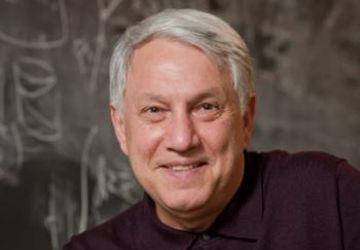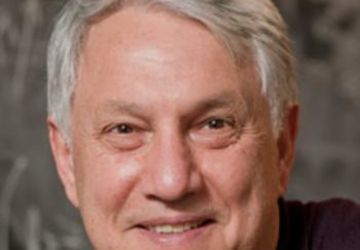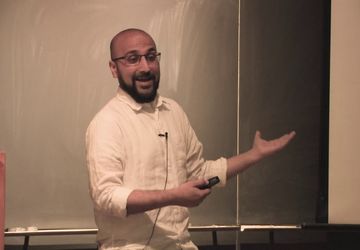Cosmology
Since its discovery by A. Linde and others, cosmic inflation -- exponential expansion of the universe driven by the potential energy contained in an `inflaton' field -- has become a successful paradigm of early universe cosmology and the origin of structure in the universe. At the same time, it leads to great theoretical problems which remain unsolved. This is a paradigm in search of a theory, and SITP members (including Dimopoulos, Kachru, Kallosh, Linde, Senatore, and Silverstein) have led a major upgrade of our understanding of the dynamics of inflation, taking into account the sensitivity of inflationary theory to quantum gravity that follows from the enormous expansion of the universe and range of the inflaton field during the process. At the same time, SITP theorists discovered an elegant characterization of observables that are captured by low energy quantum fields, and determined precisely how they are constrained by possible symmetries of nature, including a special candidate known as supersymmetry.
Read More About Cosmology
Among the major discoveries by SITP members are methods for stabilization of the extra dimensions of string theory to produce accelerated expansion in line with the observed late-universe cosmological constant, several canonical early-universe inflationary mechanisms, and a low energy effective theory of the quantum fluctuations produced during inflation. This includes the recent discovery that string theory naturally produces inflation at large field range (large as compared to the Planck scale of quantum gravity) along ubiquitous highly symmetric `axion' directions in field space, via a mathematical structure known as monodromy -- a fancy version of a spiral staircase. Microwave background experiments are actively testing the signatures of this and several other inflationary mechanisms discovered at Stanford, an unprecedented interface between quantum gravity research and data.
Despite the success of inflation as a theory of the origin of structure, it presents big conceptual challenges. Several SITP members (including Linde, Senatore, Shenker, Silverstein, and Susskind) pursue the difficult problem of deriving a more complete framework for inflationary cosmology. One set of approaches involves upgrading the AdS/CFT correspondence to cosmological backgrounds, taking into account the basic structure of the string landscape. Several interesting lessons have emerged, including remnants of lower-dimensional gravity surviving at least temporarily in the dual description, along with a pair of quantum field theory sectors. This has also led to potential observational predictions -- negative spatial curvature and signatures of exotic bubble collisions -- which apply if the early-universe inflationary expansion is minimal. A recent SITP paper (done in collaboration with a gravitational expert in KIPAC) has discovered on the other hand that the onset of inflation is quite robust even in the presence of large variations in the initial conditions, given sufficient field range. There is clearly much more to learn in this direction.
Accelerated expansion of the universe is implied by observations, and theoretically cosmological backgrounds massively dominate among the solutions of string theory (compared to the more extensively studied anti de Sitter and flat spacetimes). Current and near-future cosmic microwave background and large-scale structure measurements provide sensitive observational probes of early universe physics (as well as much interesting astrophysics). The subject is full of interesting and important challenges. As a result, this area will remain a major component of SITP research for the foreseeable future.
Video Briefs
Cosmological observations show that on the largest scales accessible to our telescopes, the…
None of us were consulted when the universe was created. And yet it is tempting to ask not only…
Black hole and cosmological horizons -- from which nothing can escape according to…
Related News

National Geographic Subscription Required -- “Our understanding of reality is not complete, by far,” says Stanford…

In Jorge Luis Borges’s story “The Book of Sand,” a mysterious Bible peddler knocks on the narrator’s door and offers to sell him a…

Image credit: L.A. Cicero
The Simons Foundation congratulates the outstanding mathematicians and theoretical physicists who have been awarded Simons Fellowships…

The G.A. Gamow Award is founded by the Russian-American Science Association (RASA-America) in memory of the outstanding Russian-American…

Congratulations to Renata Kallosh on her election to the American Academy of Arts and Sciences. Renata's election recognizes her…

Related Events
None of us were consulted when the universe was created. And yet it is tempting to ask not only how the universe evolves, but also why, and could it be different? Our universe weighs more than 1050 tons. Could it be created “…

I will argue that if the density of dark matter in the early universe is dominated by subhorizon, non-relativistic field modes, then there is a relatively model-independent bound on the mass of dark matter particles [m > 10^(-18) eV]. The…
Cosmological observations show that on the largest scales accessible to our telescopes, the universe is very uniform, and the same laws of physics operate in all the parts of it that we can see. As Andrei Linde, 2014 Kavli Prize Laureate in…

Models of dark sectors with a mass threshold can have important cosmological signatures. When a relativistic species becomes non-relativistic before recombination and is then depopulated in equilibrium, measurable effects on the CMB arise as…
Professor Eva Silverstein of the Stanford Institute for Theoretical Physics (SITP) discusses the physics of horizons, black holes, and string theory.
Black hole and cosmological horizons -- from which nothing can escape according to…
Black hole and cosmological horizons -- from which nothing can escape according to classical gravity -- play a crucial role in physics. They are central to our understanding of the origin of structure in the universe, but also lead to fascinating…

A dark force, which is a necessary ingredient of self-interacting dark matter models, can lead to gravothermal collapse of dark matter in small mass halos. This talk will review the physics of gravothermal collapse and highlight new results…

Cosmological measurements are playing a central role in our understanding of the physics related to dark sectors, in particular related to dark matter. Currently there are some noticeable tensions appearing in the data when it is interpreted…
The 8th Asian Winter School on Strings, Particles and Cosmology is part of a series that is being organized annually in turn by Korea, Japan, China and India. The school will be held in Puri, India, as a program of the International Center For…